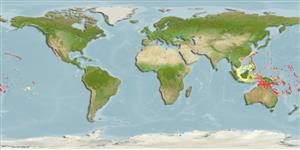>
Acanthuriformes (Surgeonfishes) >
Acanthuridae (Surgeonfishes, tangs, unicornfishes) > Acanthurinae
Etymology: Ctenochaetus: Greek, kteis, ktenos = comb + Greek, chaite = hair (Ref. 45335).
More on author: Randall.
Environment: milieu / climate zone / depth range / distribution range
Ökologie
seewasser riff-verbunden; tiefenbereich 0 - 61 m (Ref. 58302), usually 5 - 40 m (Ref. 27115). Tropical; 28°N - 26°S
Pacific Ocean: throughout most Oceania, from Micronesia, Wake and Marcus islands to the Hawaiian Islands and Pitcairn Island.
Size / Gewicht / Alter
Maturity: Lm ? range ? - ? cm
Max length : 25.0 cm TL Männchen/unbestimmt; (Ref. 9710)
Rückenflossenstacheln (insgesamt): 8; Rückenflossenweichstrahlen (insgesamt): 27-29; Afterflossenstacheln 3; Afterflossenweichstrahlen: 25 - 26. Gill rakers on anterior row 21-25, on posterior row 25. Juveniles differ greatly from adults. They have deeper bodies and are bright orange-red with numerous dark chevrons. Adults appear uniformly black from a distance but actually have numerous dark green horizontal pinstripes.
An uncommon species that inhabits seaward rocky or coral reefs (Ref. 9710). Juveniles found in relatively deep coral rich areas (Ref. 42056). Benthopelagic (Ref. 58302). Feeds on film algae (Ref. 89972). Minimum depth reported taken from Ref. 128797.
Life cycle and mating behavior
Geschlechtsreife | Fortpflanzung | Ablaichen | Eier | Fecundity | Larven
Randall, J.E and K.D. Clements, 2001. Second revision of the surgeonfish genus Ctenochaetus (Perciformes: Acanthuridae), with descriptions of two new species. Indo-Pac. Fish. (32):33 p. (Ref. 42056)
IUCN Rote Liste Status (Ref. 130435)
Bedrohung für Menschen
Harmless
Nutzung durch Menschen
Aquarium: Kommerziell
Mehr Information
NamenSynonymeMetabolismusRäuberÖkotoxikologieFortpflanzungGeschlechtsreifeAblaichenSpawning aggregationFecundityEierEientwicklung
ReferenzenAquakulturAquakultur ProfilZuchtlinienGenetikElectrophoresesVererbbarkeitKrankheitenVerarbeitungNutrientsMass conversion
PartnerBilderStamps, Coins Misc.LauteCiguateraGeschwindigkeitSchwimmstilKiemenoberflächeOtolithsGehirngrößeSehfähigkeit
Tools
Zusatzinformationen
Download XML
Internet Quellen
Estimates based on models
Preferred temperature (Ref.
123201): 24.9 - 29, mean 27.8 °C (based on 534 cells).
Phylogenetic diversity index (Ref.
82804): PD
50 = 0.5020 [Uniqueness, from 0.5 = low to 2.0 = high].
Bayesian length-weight: a=0.02344 (0.01098 - 0.05004), b=2.97 (2.80 - 3.14), in cm total length, based on LWR estimates for this (Sub)family-body shape (Ref.
93245).
Trophic level (Ref.
69278): 2.0 ±0.00 se; based on food items.
Widerstandsfähigkeit (Ref.
120179): hoch, Verdopplung der Population dauert weniger als 15 Monate. (Preliminary K or Fecundity.).
Fishing Vulnerability (Ref.
59153): Low vulnerability (15 of 100).
Nutrients (Ref.
124155): Calcium = 31.1 [19.0, 51.8] mg/100g; Iron = 0.236 [0.126, 0.567] mg/100g; Protein = 18.1 [16.8, 19.3] %; Omega3 = 0.128 [0.082, 0.203] g/100g; Selenium = 22.9 [13.2, 41.6] μg/100g; VitaminA = 43.7 [10.0, 177.3] μg/100g; Zinc = 0.369 [0.273, 1.260] mg/100g (wet weight);
